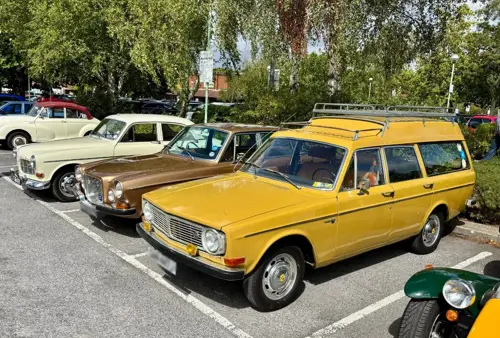Meet the owner - Tim Rose and his Volvo 145 Express
22 October 2025

One of many joys of the classic world is encountering those vehicles that you only read about in the World Car Catalogue. Tim’s 145 has all the details of the early versions – a strip speedometer, a direct-link gear lever, and fresh air vents in the footwells rather than the fascia. Most notable of all is the extended roof, for this is a 145 Express, a version not officially imported to the UK, and seen in its homeland as a taxi or even as a school minibus.
The 144 saloon debuted on the 16th of August 1966, and UK sales began in 1967. That year, Volvo introduced the 145, with imports to this country commencing in the spring of 1968. Their latest estate capitialised on the success of the 1962-1967 Amazon station wagon and Volvo GB claimed the 145 was a “down-to-earth and up-to town estate car”. Margo and Jerry Ledbetter clearly took note.
And for the up-and-coming executive or solicitor, the 145 combined practicality - a 6ft 2in load bay and room for 70 cubic feet of luggage – with undeniable prestige. Of course, it was not exactly cheap - £1,580 2s 9d was a substantial price in 1968 – but Volvo boasted that with a 145 you could “glide off to town, five up, and in armchair comfort”. Autocar thought “one grows to respect the considerable care and thought that has gone into its design in so many ways”.
However, the 145 Express had a rather different image from sherry parties and hostess trolleys when it made its bow in 1970. Volvo stated it was “intended for those of you who move things on a professional basis”. Between 1953 and 1969, the company offered the Duett, a three-door utilitarian station wagon based on the 1944-1957 PV444. It proved so popular in Sweden that it outlasted the Amazon Estate and was even produced alongside the early 145s.
The Amazon Estate and the 145 marked Volvo’s emphasis on middle-class buyers, but they believed there was a need for a successor to the Duettt. The Express’s roofline was extended by two inches from the windscreen to the B-pillar, and by a foot from the B-pillar to the tailgate. Volvo boasted:
Above the driving compartment where the roof line drops to a lower level the car has a roof rack. Between the cargo area and the front seat area is a very strong steel mesh screen. That's safety for you!
Buyers could specify a five-seater or seven-seater estate, as well as a version with two front seats and side windows only on the front doors. Volvo produced 7,218 of the Express until 1973, and they were used as taxis, ambulances, and for transporting carpenters and gardeners. Tim’s family has a long tradition of owning fascinating machines, and the 145 Express is just one member of his fleet. When he displays it at meetings of the Locks Heath Classic Car Club - https://www.locksheathclassiccarclub.co.uk/ - the mighty Volvo causes double and even triple-takes.
And who could resist the appeal of the Volvo with “a raised roof line to give engulfing spaciousness”?
With thanks to Tim Rose for his time.
With thanks to Tim Rose for the permission to use the images in this blog.
